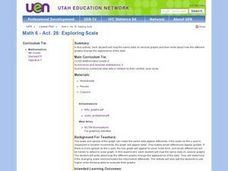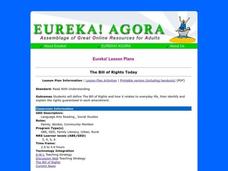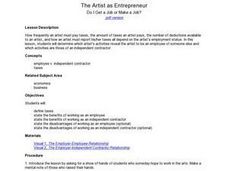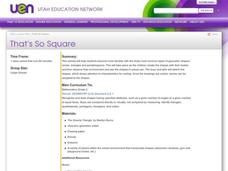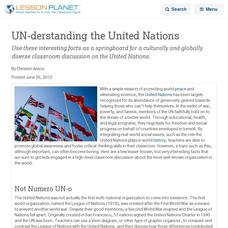Curated OER
Exploring Scale
Sixth graders discuss how the scale and type of graph can change how the data appears. With a partner, they identify all the information about the graph in a specific amount of time and record them in a journal. To end the lesson, they...
Curated OER
The African-American Struggle for Equality in the World War II Era
Students respect and appreciate the challenges people faced during World War II. They develop the different perspectives on race during WWII. Students develop that the nation's actions may not exemplify a nation's stated ideals. Students...
Curated OER
Mapping the changes in Canada's population
Students find and analyze data found in the census. They compare the population from 1996 to 2001. They explore the type of data they can find in the Census of Population.
Curated OER
Anne Frank: Everything Changed for Us
Young scholars write about a time they were made to feel different, and when they were on the other side of the equation. They read other first hand accounts of times in history when people were made to feel like outsiders.
Curated OER
Accessories
Students are introduced to the types of accessories available in fashion. In groups, they are given a piece of clothing and are to accessorize it properly. As a class, they use this same reasoning and apply it to an interior room. To...
Curated OER
Alternative Energy
Students identify the five major alternative energy sources. In this physical science lesson, students assess the advantages and disadvantages for each type of energy. They complete a concept map using information they researched.
Curated OER
The Bill of Rights Today
Learners examine the Bill of Rights, They read the Bill of Rights and clarify the meaning of the material using different reading strategies. In groups, students brainstorm to compare and evaluate their conclusions with those of others.
Curated OER
Pie Crust Experiment
This experiment can be used as a pre-assessment to see what experience and knowledge the students have in preparing pies. They identify the difference in taste, flavor, texture and appearance as they substitute different ingredients for...
Curated OER
For All Time
Students explore the oldest building in their community, then if any have gargoyles. They explore the date of the buildings and what types of materials were used to build the building.
Curated OER
Volcanoes
Fifth graders study volcanoes. They watch a demonstration that represents the eruption of a volcano and discuss the similarities and differences between the model and a real volcano.
Curated OER
External Influences 1
Students discover the main objectives of the government. They apply economic data to different scenerios. They present their findings to the class.
Curated OER
The Reservations
Third graders investigate the concept of a reservation and how it effects the lives of Native American indian tribes. They conduct research with the help of guiding questions to find the correct type of information. Students take notes...
Curated OER
Auditing the Energy-Guzzlers in Your Home
Students identify the energy sources in their community as renewable or non-renewable resources. Using their homes, they identify the types of energy they use to heat and power it. They calculate the amount of electricity used by each...
Curated OER
International Summit on Asia
Middle schoolers consider different aspects of Asia to determine which Asian country they think would be the best location for the American business development. They engage in a series of lessons designed to examine regions of Asia,...
Curated OER
The Artist as Entrepreneur: Do I Get a Job or Make a Job?
Students discover the differences in being an entrepreneurial artist and an employed artist. They explore the tax codes, copyright laws and fringe benefits of being an employee versus an independent contractor.
Curated OER
Color Selection for a Quilt
Students discuss the importance of using the proper color combinations in a quilt. In groups, they use the color wheel to design their section of the quilt for the class. To end the lesson, they are introduced to the various types of...
Curated OER
Coping with Crying/Shaken Baby Syndrome
High schoolers listen as an expert on Shaken Baby syndrome speaks to their class and asks appropriate questions. Using a computerized doll, they discover the meanings behind baby's different crys and demonstrates what happens when a...
Curated OER
That's So Square
Second graders are introduced to circles, triangles and parallelograms. As a class, they create the shape with their bodies and are shown the shapes in their actual size. To end the lesson, they sketch each shape and identify their...
Curated OER
Engineering in a Calculus Classroom
Students solve several differential equations. In this calculus lesson, students test their modulus calculation by testing different weights or beam lengths. They share their findings in class.
Curated OER
UN-derstanding the United Nations
Use these interesting facts as a springboard for a culturally and globally diverse classroom discussion on the United Nations.
Roy Rosenzweig Center for History and New Media
Immigrant Discrimination
For a class learning about Chinese and Irish immigration in America, here's a great starting lesson plan. It has your critical thinkers examining song lyrics, the Chinese Exclusion Act of 1882, and a political cartoon, and finally...
Curated OER
Analyzing Primary Sources
Analyzing primary and secondary sources is a necessary skill for students to attain, and can be learned through interesting activities.
Curated OER
Social Studies: Exploring Japan
Fourth graders examine the culture and environment of Japan, beginning with a KWL chart. They use clay and cups of water to construct representations of the Japanese Islands. After designing flags representing farming and food, 4th...
Big History Project
Human Migration Patterns II
While humans have always been on the move, the period between 1400 and 1800 saw vast migrations of people between the East and the West. These migrations—whether through slavery or a desire to colonize new lands—shaped the modern world....


